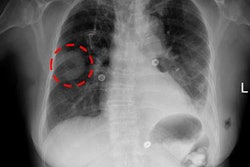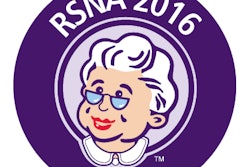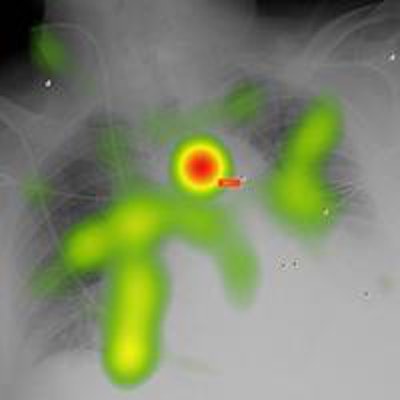
RSNA is teaming up with the U.S. National Cancer Institute (NCI) to sponsor a week of image perception research starring you -- the radiologist. You're a notoriously hard-to-recruit demographic, but organizers hope to entice you into participation with promises of swag and a chance to do great things during RSNA 2016 in Chicago.
Most research into image perception -- that is, seeing where people's eyes go when they look, measuring what they notice, and the like -- is performed by low-cost, untrained volunteers. The problem is that basic vision research findings offer little value to radiology researchers who want to know what radiologists -- not ordinary people -- see in their images.
"The hardest part of medical image perception is that you can't get a collection of observers the way you can for more basic visual perception research," said Dr. Jeremy Wolfe, PhD, in an interview with AuntMinnie.com.
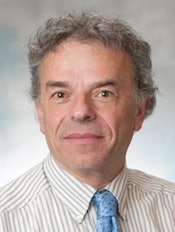 Dr. Jeremy Wolfe, PhD, from Harvard Medical School.
Dr. Jeremy Wolfe, PhD, from Harvard Medical School.Board-certified radiologists "are fantastically busy," and there are always more cases waiting to be read, said Wolfe, who is a professor of ophthalmology and radiology at Harvard Medical School and Brigham and Women's Hospital in Boston. Reaching out to them when they are found outside of their natural environment -- the reading room -- might be more productive.
"What we're hoping for is that if we go to RSNA where there are lots of radiologists who aren't currently reading cases and who might have some downtime, we might be able to persuade them to participate in relatively brief experiences in visual perception in a topic that interests them," Wolfe said.
Wolfe hopes attendees at RSNA 2016 will have time for what organizers promise will be brief experiments lasting no longer than 30 minutes, and for which they'll have a chance to earn incentive gifts, such as by entering a drawing for an iPad.
With funding assistance from the NCI, the RSNA will build four darkened rooms in the education area at McCormick Place, each equipped with a desk, two chairs, internet access, two 47-inch monitors, and a registration area where participants can sign up for studies.
Opportunities for researchers
The setting offers advantages to potential researchers as well -- notably, providing them with lots of radiologists to conduct the experiments with, Wolfe said.
"If you want to run an experiment, send us a proposal," he said.
Maybe you're not working in a hospital setting with access to lots of readers. Maybe you have little experience in putting together the resources for a large, multireader imaging perception study, but "we've done that infrastructure for you," he said. The radiologists and PhDs on the steering committee will evaluate all imaging perception study proposals and work with the research team to make them happen during the meeting.
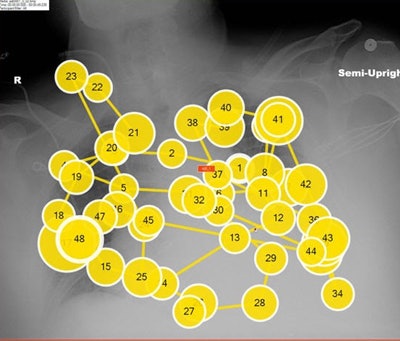 Above, eye-tracking scan path; below, heat map representing where observers looked. Images courtesy of Elizabeth Krupinski, PhD, Emory University.
Above, eye-tracking scan path; below, heat map representing where observers looked. Images courtesy of Elizabeth Krupinski, PhD, Emory University.A wide variety of imaging perception studies are needed, and Wolfe offered up examples of the kinds of studies that qualify as imaging perception research:
- Instead of comparing last year's mammography image on the left with this year's on the right, the images could be coregistered and superimposed directly on top of each other: One would appear briefly, followed by the other toggled in the same place, and then the original would return, over and over again. Would a new tumor "jump out at you," Wolfe asked, if you didn't have to spend time and energy moving your eyes back and forth to look at two images?
- In another mammography example, Jay Hegdé, PhD, and colleagues at the Medical College of Georgia have been working with textural information in breast images. For example, if an advanced visualization algorithm is tasked with texture analysis of regions of interest (ROIs) in mammography images, will the radiologist choose ROIs for analysis where the algorithm finds patterns consistent with malignancy? Or will most selected ROIs be normal? Do humans perform this task similarly to the computer? Whatever the answer, there is real value in the information for the development of computer-aided detection schemes, Wolfe said.
- Another study idea involves eye-tracking in chest CT. Prior studies have looked at where the eyes go in the x- and y-axes -- left to right or up and down the 2D image. However, chest CT reading is performed on a stack of images in the x, y, and z planes, and 2D eye-tracking can't tell how deep in the stack the radiologist might be staring, or whether the reading patterns of novices and experts are similar.
Applying for research slots
RSNA attendees interested in having the project host their visual perception studies are invited to send detailed information to the project organizers, including the name and contact information of the principal investigator, a description of the study and why it's worth doing, how many participants they hope to attract, what incentives they can offer to participants, and how many two-hour slots they anticipate needing in the facility, according to Wolfe. Accepted studies will need proof of institutional review board (IRB) approval and more detailed information.
Questions may be directed to Wolfe ([email protected]) or to Todd Horowitz at the National Institutes of Health/NCI ([email protected]).
Big world to see
Radiology image perception research is only a small part of the much bigger world of vision research. Both could benefit from more exposure to each other, Wolfe said.
"The medical imaging perception community is a small group, and we really want to raise its profile in the broader vision research community," he said. "The two communities have a lot to say to each other -- the NCI certainly thought so -- and I think this project will have real and useful consequences. I hope it's a huge, roaring success."





